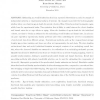Free Online Productivity Tools
i2Speak
i2Symbol
i2OCR
iTex2Img
iWeb2Print
iWeb2Shot
i2Type
iPdf2Split
iPdf2Merge
i2Bopomofo
i2Arabic
i2Style
i2Image
i2PDF
iLatex2Rtf
Sci2ools
CSDA
2011
2011
Functional density synchronization
Estimating an overall density function from repeated observations on each of a sample of independent subjects or experimental units is of interest. An example is provided by biodemographic studies, where one observes age-at-death for several cohorts of flies. Cohorts are kept in separate cages, which form the experimental units. Time-variation then is likely to exist between the cohort densities and hazard rates due to cage effects on aging. Given the densities of age-at-death for the individual cohorts, one aims to obtain an estimate for the underlying overall density and hazard rate. In microarray gene expression experiments, similar problems arise when addressing the need for normalization of probe-level data from different arrays. Conventional methods, such as the cross-sectional average density, ignore time variation and hence are often not representative for such data. We view densities as functional data and model individual densities as warped versions of an underlying overa...
| Added | 13 May 2011 |
| Updated | 13 May 2011 |
| Type | Journal |
| Year | 2011 |
| Where | CSDA |
| Authors | Zhen Zhang, Hans-Georg Müller |
Comments (0)

